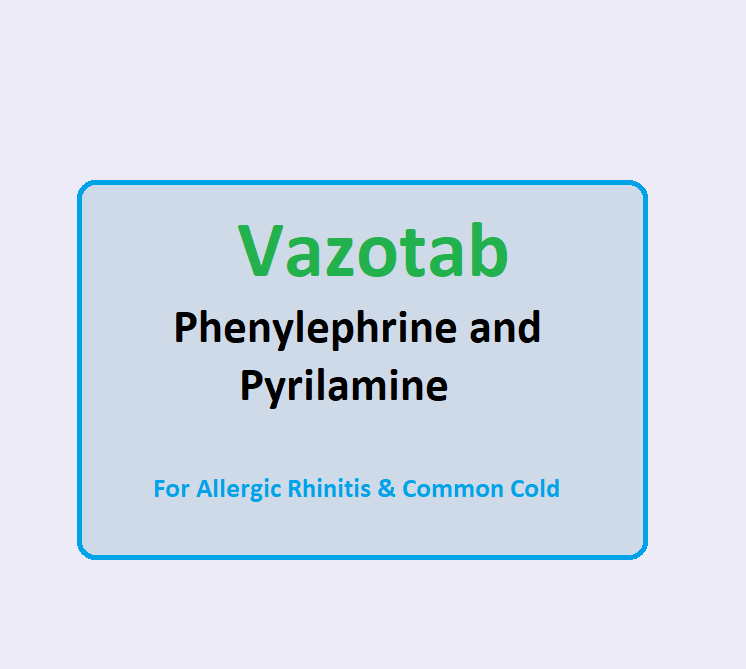Vazotab (Phenylephrine and Pyrilamine) is a combination of a decongestant and antihistamine that is used for the symptomatic treatment of allergic rhinitis and other respiratory tract symptoms.
Phenylephrine and pyrilamine Uses:
- Allergic rhinitis:
- It is indicated for the treatment of nasal congestion, rhinitis (runny nose), sneezing, itchy nose and throat, and itchy watery eyes due to allergic rhinitis, other upper respiratory tract allergies, and the common cold.
Vazotab (Phenylephrine and Pyrilamine) Dose in Adults
Vazotab (Phenylephrine and Pyrilamine) Dose in the Treatment of allergic rhinitis: Oral:
- Liquid Suspension (5 mg phenylephrine + 16 mg pyrilamine per 5 mL):
- Take 5 to 10 milliliters (mL) every 6 hours.
- Don't take more than 40 mL within 24 hours.
- Tablet (10 mg phenylephrine + 25 mg pyrilamine):
- Take one tablet every 4 to 6 hours.
- Don't take more than 6 tablets within 24 hours.
Vazotab (Phenylephrine and Pyrilamine) Dose in Childrens
Vazotab (Phenylephrine and Pyrilamine) Dose in the Treatment of allergic rhinitis: Oral:
For Children 6 to 11 Years:
- Liquid Suspension (5 mg phenylephrine + 16 mg pyrilamine per 5 mL):
- Take 5 mL every 6 hours.
- Don't take more than 20 mL within 24 hours.
- Tablet (10 mg phenylephrine + 25 mg pyrilamine):
- Take half a tablet every 4 to 6 hours.
- Don't take more than 3 tablets within 24 hours.
For Children 12 Years and Older, including Adolescents:
- Follow the instructions for adults.
Pregnancy Risk Category: C
- This combination has not been tested in pregnant or lactating women. OTC medicine should be used for no more than three days during pregnancy to avoid systemic absorption.
- This could lead to fetal ischemia.
Phenylephrine and Pyrilamine Use in Renal disease:
No dosage adjustments have been recommended by the manufacturer.
Phenylephrine and Pyrilamine Use in Liver disease:
No dosage adjustments have been recommended by the manufacturer.
Side effects of Vazotab (Phenylephrine and Pyrilamine):
- Cardiovascular:
- Cardiac Arrhythmia
- Hypertension
- Hypotension
- Palpitations
- Central Nervous System:
- Ataxia
- Drowsiness
- Dysphoria
- Euphoria
- Headache
- Insomnia
- Irritability
- Nervousness
- Sedation
- Seizure
- Dermatologic:
- Pruritus
- Skin Photosensitivity
- Skin Rash
- Urticaria
- Gastrointestinal:
- Anorexia
- Constipation
- Diarrhea
- Epigastric Distress
- Nausea
- Vomiting
- Xerostomia
- Genitourinary:
- Difficulty In Micturition
- Urinary Frequency
- Hematologic & Oncologic:
- Agranulocytosis
- Hemolytic Anemia
- Thrombocytopenia
- Neuromuscular & Skeletal:
- Tremor
- Weakness
- Ophthalmic:
- Visual Disturbance
- Respiratory:
- Dyspnea
- Wheezing
Contraindications to Vazotab (Phenylephrine and Pyrilamine):
- Don't use this over-the-counter (OTC) medicine if you've taken MAO inhibitors in the last 14 days.
- And don't use it for more than 3 days at a time when treating yourself.
MAO inhibitors are a type of medication, and using them too close to this OTC medicine or using this medicine for too long can cause problems.
Warnings and precautions
CNS depression:
- This medicine may make your brain and body slow down a bit.
- Be careful with activities that need you to be fully awake and alert, like driving or using heavy machinery.
- So, be cautious and avoid doing things that require sharp thinking if you're taking this medicine.
Cardiovascular disease
- If you have heart problems, be careful when using this medicine.
Diabetes:
- If you have diabetes, be careful when using this medicine.
Glaucoma/increased intraocular pressure
- If you have high eye pressure or glaucoma, be cautious when using this medicine.
Prostatic hyperplasia/urinary block:
- If you have a condition called prostatic hyperplasia or problems with urination, be careful when using this medicine.
Respiratory disease
- If you have trouble breathing, like chronic bronchitis or emphysema, be cautious when using this medicine.
Thyroid dysfunction:
- If you have a thyroid problem, be careful when using this medicine.
Phenylephrine and pyrilamine: Drug Interaction
Note: Drug Interaction Categories:
- Risk Factor C: Monitor When Using Combination
- Risk Factor D: Consider Treatment Modification
- Risk Factor X: Avoid Concomitant Use
|
Risk Factor C (Monitor therapy) |
|
|
Acetaminophen |
May increase the serum concentration of Phenylephrine (Systemic). |
|
Acetylcholinesterase Inhibitors |
May diminish the therapeutic effect of Anticholinergic Agents. Anticholinergic Agents may diminish the therapeutic effect of Acetylcholinesterase Inhibitors. |
|
Alcohol (Ethyl) |
CNS Depressants may enhance the CNS depressant effect of Alcohol (Ethyl). |
|
Alizapride |
May enhance the CNS depressant effect of CNS Depressants. |
|
Alpha1-Blockers |
May diminish the vasoconstricting effect of Alpha1-Agonists. Similarly, Alpha1Agonists may antagonize Alpha1-Blocker vasodilation. |
|
May enhance the anticholinergic effect of Anticholinergic Agents. |
|
|
Amezinium |
Antihistamines may enhance the stimulatory effect of Amezinium. |
|
Amphetamines |
May diminish the sedative effect of Antihistamines. |
|
Anticholinergic Agents |
May enhance the adverse/toxic effect of other Anticholinergic Agents. |
|
May enhance the hypertensive effect of Sympathomimetics. AtoMOXetine may enhance the tachycardic effect of Sympathomimetics. |
|
|
Betahistine |
Antihistamines may diminish the therapeutic effect of Betahistine. |
|
Botulinum Toxin-Containing Products |
May enhance the anticholinergic effect of Anticholinergic Agents. |
|
Brexanolone |
CNS Depressants may enhance the CNS depressant effect of Brexanolone. |
|
Brimonidine (Topical) |
May enhance the CNS depressant effect of CNS Depressants. |
|
Bromopride |
May enhance the CNS depressant effect of CNS Depressants. |
|
Cannabidiol |
May enhance the CNS depressant effect of CNS Depressants. |
|
Cannabis |
May enhance the CNS depressant effect of CNS Depressants. |
|
Chloral Betaine |
May enhance the adverse/toxic effect of Anticholinergic Agents. |
|
May enhance the hypertensive effect of Phenylephrine (Systemic). |
|
|
Chlorphenesin Carbamate |
May enhance the adverse/toxic effect of CNS Depressants. |
|
CloZAPine |
May diminish the therapeutic effect of Phenylephrine (Systemic). |
|
CNS Depressants |
May enhance the adverse/toxic effect of other CNS Depressants. |
|
Dimethindene (Topical) |
May enhance the CNS depressant effect of CNS Depressants. |
|
Doxofylline |
Sympathomimetics may enhance the adverse/toxic effect of Doxofylline. |
|
May enhance the CNS depressant effect of CNS Depressants. Management: The manufacturer of Diclegis (doxylamine/pyridoxine), intended for use in pregnancy, specifically states that use with other CNS depressants is not recommended. |
|
|
May enhance the CNS depressant effect of CNS Depressants. |
|
|
May enhance the CNS depressant effect of CNS Depressants. |
|
|
Gastrointestinal Agents (Prokinetic) |
Anticholinergic Agents may diminish the therapeutic effect of Gastrointestinal Agents (Prokinetic). |
|
Anticholinergic Agents may enhance the adverse/toxic effect of Glucagon. Specifically, the risk of gastrointestinal adverse effects may be increased. |
|
|
Guanethidine |
May enhance the arrhythmogenic effect of Sympathomimetics. Guanethidine may enhance the hypertensive effect of Sympathomimetics. |
|
May enhance the CNS depressant effect of CNS Depressants. |
|
|
Ioflupane I 123 |
Phenylephrine (Systemic) may diminish the diagnostic effect of Ioflupane I 123. |
|
Itopride |
Anticholinergic Agents may diminish the therapeutic effect of Itopride. |
|
Kava Kava |
May enhance the adverse/toxic effect of CNS Depressants. |
|
May enhance the CNS depressant effect of CNS Depressants. Management: Drugs listed as exceptions to this monograph are discussed in further detail in separate drug interaction monographs. |
|
|
May enhance the CNS depressant effect of CNS Depressants. |
|
|
CNS Depressants may enhance the sedative effect of MetyroSINE. |
|
|
Mianserin |
May enhance the anticholinergic effect of Anticholinergic Agents. |
|
May enhance the CNS depressant effect of CNS Depressants. |
|
|
Mirabegron |
Anticholinergic Agents may enhance the adverse/toxic effect of Mirabegron. |
|
CNS Depressants may enhance the CNS depressant effect of Mirtazapine. |
|
|
May enhance the CNS depressant effect of CNS Depressants. |
|
|
Nitroglycerin |
Anticholinergic Agents may decrease the absorption of Nitroglycerin. Specifically, anticholinergic agents may decrease the dissolution of sublingual nitroglycerin tablets, possibly impairing or slowing nitroglycerin absorption. |
|
Piribedil |
CNS Depressants may enhance the CNS depressant effect of Piribedil. |
|
Pramipexole |
CNS Depressants may enhance the sedative effect of Pramipexole. |
|
Propacetamol |
May increase the serum concentration of Phenylephrine (Systemic). Management: Monitor patients closely for increased side effects of phenylephrine if propacetamol is used concomitantly. Patients with underlying blood pressure issues or arrhythmias may need closer monitoring and may warrant consideration of alternative therapies. |
|
Ramosetron |
Anticholinergic Agents may enhance the constipating effect of Ramosetron. |
|
ROPINIRole |
CNS Depressants may enhance the sedative effect of ROPINIRole. |
|
Rotigotine |
CNS Depressants may enhance the sedative effect of Rotigotine. |
|
May enhance the adverse/toxic effect of CNS Depressants. Specifically, sleepiness and dizziness may be enhanced. |
|
|
Selective Serotonin Reuptake Inhibitors |
CNS Depressants may enhance the adverse/toxic effect of Selective Serotonin Reuptake Inhibitors. Specifically, the risk of psychomotor impairment may be enhanced. |
|
Solriamfetol |
Sympathomimetics may enhance the hypertensive effect of Solriamfetol. |
|
Sympathomimetics |
May enhance the adverse/toxic effect of other Sympathomimetics. |
|
May enhance the hypertensive effect of Sympathomimetics. Tedizolid may enhance the tachycardic effect of Sympathomimetics. |
|
|
Tetrahydrocannabinol |
May enhance the CNS depressant effect of CNS Depressants. |
|
Tetrahydrocannabinol and Cannabidiol |
May enhance the CNS depressant effect of CNS Depressants. |
|
Thiazide and Thiazide-Like Diuretics |
Anticholinergic Agents may increase the serum concentration of Thiazide and Thiazide-Like Diuretics. |
|
Anticholinergic Agents may enhance the adverse/toxic effect of Topiramate. |
|
|
Tricyclic Antidepressants |
May enhance the therapeutic effect of Alpha1-Agonists. Tricyclic Antidepressants may diminish the therapeutic effect of Alpha1-Agonists. |
|
Trimeprazine |
May enhance the CNS depressant effect of CNS Depressants. |
|
Risk Factor D (Consider therapy modification) |
|
|
Benzylpenicilloyl Polylysine |
Antihistamines may diminish the diagnostic effect of Benzylpenicilloyl Polylysine. Management: Suspend systemic H1 antagonists for benzylpenicilloyl-polylysine skin testing and delay testing until systemic antihistaminic effects have dissipated. A histamine skin test may be used to assess persistent antihistaminic effects. |
|
Benzylpenicilloyl Polylysine |
Alpha1-Agonists may diminish the diagnostic effect of Benzylpenicilloyl Polylysine. Management: Consider use of a histamine skin test as a positive control to assess a patient's ability to mount a wheal and flare response. |
|
Blonanserin |
CNS Depressants may enhance the CNS depressant effect of Blonanserin. |
|
CNS Depressants may enhance the CNS depressant effect of Buprenorphine. Management: Consider reduced doses of other CNS depressants, and avoiding such drugs in patients at high risk of buprenorphine overuse/self-injection. Initiate buprenorphine at lower doses in patients already receiving CNS depressants. |
|
|
Chlormethiazole |
May enhance the CNS depressant effect of CNS Depressants. Management: Monitor closely for evidence of excessive CNS depression. The chlormethiazole labeling states that an appropriately reduced dose should be used if such a combination must be used. |
|
Cocaine (Topical) |
May enhance the hypertensive effect of Sympathomimetics. Management: Consider alternatives to use of this combination when possible. Monitor closely for substantially increased blood pressure or heart rate and for any evidence of myocardial ischemia with concurrent use. |
|
May enhance the CNS depressant effect of CNS Depressants. Management: Consider dose reductions of droperidol or of other CNS agents (eg, opioids, barbiturates) with concomitant use. Exceptions to this monograph are discussed in further detail in separate drug interaction monographs. |
|
|
Flunitrazepam |
CNS Depressants may enhance the CNS depressant effect of Flunitrazepam. |
|
CNS Depressants may enhance the CNS depressant effect of HYDROcodone. Management: Avoid concomitant use of hydrocodone and benzodiazepines or other CNS depressants when possible. These agents should only be combined if alternative treatment options are inadequate. If combined, limit the dosages and duration of each drug. |
|
|
Linezolid |
May enhance the hypertensive effect of Sympathomimetics. Management: Reduce initial doses of sympathomimetic agents, and closely monitor for enhanced pressor response, in patients receiving linezolid. Specific dose adjustment recommendations are not presently available. |
|
Methotrimeprazine |
CNS Depressants may enhance the CNS depressant effect of Methotrimeprazine. Methotrimeprazine may enhance the CNS depressant effect of CNS Depressants. Management: Reduce adult dose of CNS depressant agents by 50% with initiation of concomitant methotrimeprazine therapy. Further CNS depressant dosage adjustments should be initiated only after clinically effective methotrimeprazine dose is established. |
|
Opioid Agonists |
CNS Depressants may enhance the CNS depressant effect of Opioid Agonists. Management: Avoid concomitant use of opioid agonists and benzodiazepines or other CNS depressants when possible. These agents should only be combined if alternative treatment options are inadequate. If combined, limit the dosages and duration of each drug. |
|
CNS Depressants may enhance the CNS depressant effect of OxyCODONE. Management: Avoid concomitant use of oxycodone and benzodiazepines or other CNS depressants when possible. These agents should only be combined if alternative treatment options are inadequate. If combined, limit the dosages and duration of each drug. |
|
|
May enhance the CNS depressant effect of CNS Depressants. Management: Patients taking perampanel with any other drug that has CNS depressant activities should avoid complex and high-risk activities, particularly those such as driving that require alertness and coordination, until they have experience using the combination. |
|
|
Pramlintide |
May enhance the anticholinergic effect of Anticholinergic Agents. These effects are specific to the GI tract. |
|
Secretin |
Anticholinergic Agents may diminish the therapeutic effect of Secretin. Management: Avoid concomitant use of anticholinergic agents and secretin. Discontinue anticholinergic agents at least 5 half-lives prior to administration of secretin. |
|
May enhance the CNS depressant effect of CNS Depressants. Management: Consider alternatives to combined use. When combined use is needed, consider minimizing doses of one or more drugs. Use of sodium oxybate with alcohol or sedative hypnotics is contraindicated. |
|
|
CNS Depressants may enhance the CNS depressant effect of Suvorexant. Management: Dose reduction of suvorexant and/or any other CNS depressant may be necessary. Use of suvorexant with alcohol is not recommended, and the use of suvorexant with any other drug to treat insomnia is not recommended. |
|
|
May enhance the CNS depressant effect of CNS Depressants. Management: Avoid concomitant use of tapentadol and benzodiazepines or other CNS depressants when possible. These agents should only be combined if alternative treatment options are inadequate. If combined, limit the dosages and duration of each drug. |
|
|
CNS Depressants may enhance the CNS depressant effect of Zolpidem. Management: Reduce the Intermezzo brand sublingual zolpidem adult dose to 1.75 mg for men who are also receiving other CNS depressants. No such dose change is recommended for women. Avoid use with other CNS depressants at bedtime; avoid use with alcohol. |
|
|
Risk Factor X (Avoid combination) |
|
|
Aclidinium |
May enhance the anticholinergic effect of Anticholinergic Agents. |
|
Azelastine (Nasal) |
CNS Depressants may enhance the CNS depressant effect of Azelastine (Nasal). |
|
Bromperidol |
May enhance the CNS depressant effect of CNS Depressants. |
|
Cimetropium |
Anticholinergic Agents may enhance the anticholinergic effect of Cimetropium. |
|
Anticholinergic Agents may enhance the constipating effect of Eluxadoline. |
|
|
Ergot Derivatives |
May enhance the hypertensive effect of Alpha1-Agonists. Ergot Derivatives may enhance the vasoconstricting effect of Alpha1-Agonists. Exceptions: Ergoloid Mesylates; Nicergoline. |
|
Glycopyrrolate (Oral Inhalation) |
Anticholinergic Agents may enhance the anticholinergic effect of Glycopyrrolate (Oral Inhalation). |
|
Glycopyrronium (Topical) |
May enhance the anticholinergic effect of Anticholinergic Agents. |
|
Hyaluronidase |
May enhance the vasoconstricting effect of Phenylephrine (Systemic). Management: Avoid the use of hyaluronidase to enhance dispersion or absorption of phenylephrine. Use of hyaluronidase for other purposes in patients receiving phenylephrine may be considered as clinically indicated. |
|
Iobenguane Radiopharmaceutical Products |
Alpha1-Agonists may diminish the therapeutic effect of Iobenguane Radiopharmaceutical Products. Management: Discontinue all drugs that may inhibit or interfere with catecholamine transport or uptake for at least 5 biological half-lives before iobenguane administration. Do not administer these drugs until at least 7 days after each iobenguane dose. |
|
Ipratropium (Oral Inhalation) |
May enhance the anticholinergic effect of Anticholinergic Agents. |
|
Levosulpiride |
Anticholinergic Agents may diminish the therapeutic effect of Levosulpiride. |
|
Monoamine Oxidase Inhibitors |
May enhance the hypertensive effect of Alpha1-Agonists. While linezolid is expected to interact via this mechanism, management recommendations differ from other monoamine oxidase inhibitors. Refer to linezolid specific monographs for details. Exceptions: Linezolid; Tedizolid. |
|
Orphenadrine |
CNS Depressants may enhance the CNS depressant effect of Orphenadrine. |
|
Oxatomide |
May enhance the anticholinergic effect of Anticholinergic Agents. |
|
Oxomemazine |
May enhance the CNS depressant effect of CNS Depressants. |
|
Paraldehyde |
CNS Depressants may enhance the CNS depressant effect of Paraldehyde. |
|
Antihistamines may diminish the therapeutic effect of Pitolisant. |
|
|
Anticholinergic Agents may enhance the ulcerogenic effect of Potassium Chloride. Management: Patients on drugs with substantial anticholinergic effects should avoid using any solid oral dosage form of potassium chloride. |
|
|
Potassium Citrate |
Anticholinergic Agents may enhance the ulcerogenic effect of Potassium Citrate. |
|
Anticholinergic Agents may enhance the anticholinergic effect of Revefenacin. |
|
|
CNS Depressants may enhance the CNS depressant effect of Thalidomide. |
|
|
Anticholinergic Agents may enhance the anticholinergic effect of Tiotropium. |
|
|
May enhance the anticholinergic effect of Anticholinergic Agents. |
|
Monitoring Parameters:
- Monitor the response to therapy.
- Observe for symptoms of sympathetic overdrive such as tachycardia and hypertension.
How to administer?
- Prime the spray first.
- Insert the nozzle into one nostril and squeeze the spray blocking the other nostril.
- Inhale with the nostril that has been medicated.
Mechanism of action of Vazotab (Phenylephrine and Pyrilamine):
- Phenylephrine hydrochloride helps clear congestion by mimicking certain signals in your body, primarily affecting alpha receptors. It's a decongestant.
- Pyrilamine works by blocking signals from H-receptors, which helps in reducing symptoms related to allergies. It's an H-receptor antagonist.
- Together, they are often combined in medications to provide relief for both congestion and allergy symptoms.
International Brand Names of Phenylephrine and pyrilamine:
- Glen PE
- Vazotab
Phenylephrine and pyrilamine Brand Names in Pakistan:
|
Phenylephrine (HCl) Syrup 5 mg/5ml in Pakistan |
|
|
Tussivil |
Pfizer Laboratories Ltd. |




 Injection.webp)